"In Vietnam, I quickly understood that a smile was much more than just a facial expression. It's a true mode of communication, a way to say hello, thank you, or simply to show openness to interaction. Even if I didn't always understand what was being said to me, a smile was enough to create a warm and welcoming atmosphere." Alain DN
"While visiting a Buddhist temple, I realized that my outfit might have been a bit too casual. I saw other travelers borrowing sarongs to cover their shoulders. I did the same to show respect for the sacred places." Cathy B.
Introduction
Embarking on the Vietnamese adventure means being ready to venture off the beaten path and experience unique moments. Beyond discovering breathtaking landscapes and thrilling activities, it is crucial to understand the local cultural codes. By introducing these testimonies from two of our travelers, we aim to prepare you to face this double challenge: fully live your adventure while respecting Vietnamese traditions. Even if they may sometimes seem puzzling.
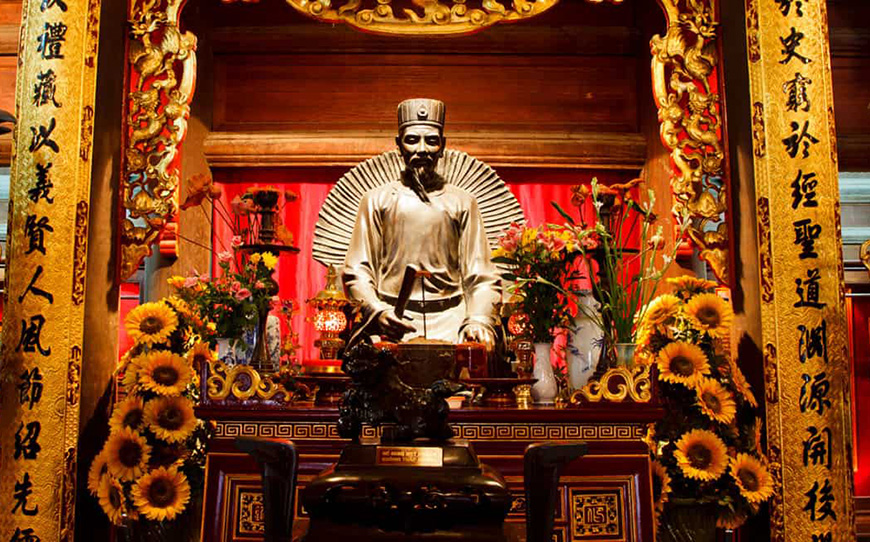
Confucianism, a pillar of Vietnamese society - Source : lonely planet
Vietnam, a blend of ancient traditions and modern openness
Vietnam, a country of many facets, presents a fascinating spectacle where age-old traditions and modernity gracefully intertwine. This Southeast Asian country, rich in millennia-old history, has preserved its customs while embracing progress, creating a unique and captivating cultural mix. For any traveler eager to delve into this enchanting culture, understanding and respecting local etiquette are more than just formalities: they are the key to an authentic and enriching experience.
Cultural foundations of Vietnamese etiquette
Vietnamese etiquette draws its roots from the two major philosophies that have shaped the soul of the country: Confucianism and Buddhism. Confucianism, a true pillar of Vietnamese society, instilled deep values of respect towards elders, hierarchy, family, and community. These principles are reflected in every social interaction, where harmony and mutual consideration prevail. In parallel, Buddhism brought a touch of serenity and tolerance to Vietnamese culture. Notions of non-violence, compassion, and humility permeate daily life, inviting everyone to cultivate kindness in their relationships with others.
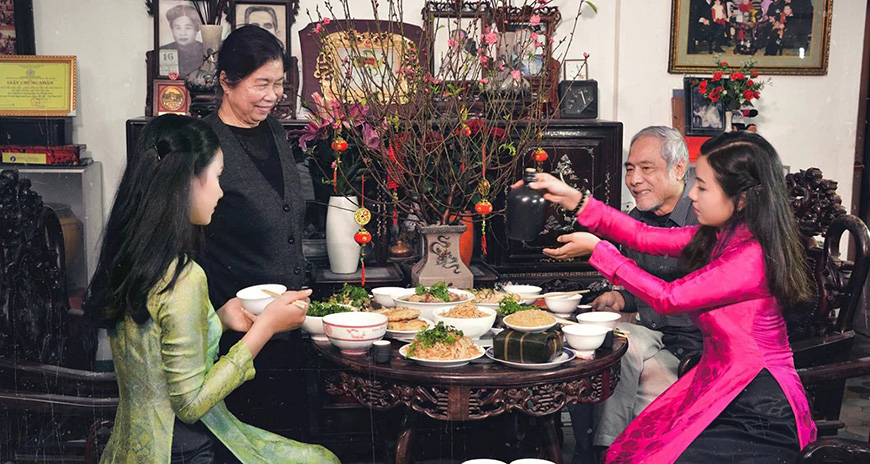
Vietnam values respect towards elders, hierarchy, family, and community - Source : Internet
What to avoid
In this context, certain behaviors are to be avoided in order not to offend the local sensibilities.
Losing one's temper, for example, is perceived as a lack of self-control and can seriously harm relationships. Vietnamese people greatly value patience and delicacy; thus, showing signs of impatience or rushing someone can be misinterpreted.
It is also crucial to respect social hierarchy by avoiding excessive familiarity, especially towards the elderly. One should refrain from any intimate gestures (no, not even a kiss) in public.
Direct criticisms are rarely well-received; it is preferable to opt for more subtle and diplomatic phrasing.
Even a gesture as innocuous as pointing can be considered impolite; we prefer to use our open hand to point at something (although from experience, I'd say we'd rather point in a direction by opening our hand while pointing our arm in the direction).
Topics to avoid in conversation include politics and money.
Tips for a successful immersion
For a successful immersion in Vietnamese culture, some tips are essential.
The smile, universal and warm, is a powerful tool of charm in Vietnam. It opens many doors and softens numerous situations.
Greetings deserve particular attention: a slight nod of the head accompanied by a smile is usually sufficient, but a slight bow of the body may be appropriate to show greater respect, especially towards elders (learn more below). While greeting by placing hands together in front and bowing is common in Thailand, Laos, or Cambodia, in Vietnam, this greeting is reserved for monks.
Age is not a taboo, even for women. It is very common to be asked your age from the first encounters. Vietnamese people do not hesitate to ask other questions that may seem intrusive to a Westerner, such as marital status or even salary. Do not view these questions as an intrusion into your private life, but rather as an expression of interest and a way to position yourself in the social hierarchy (personal pronouns differ according to gender, age, social and/or family ties...).
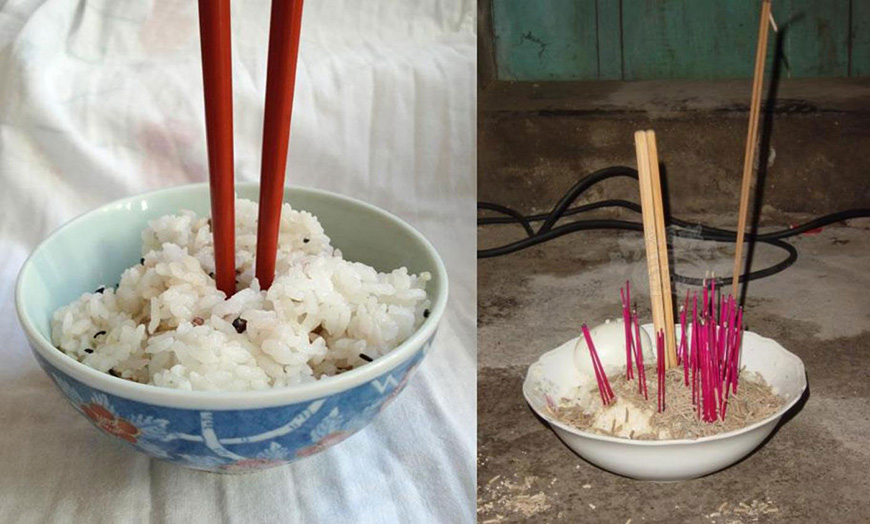
Never stick your chopsticks vertically into the rice bowl - Source : Internet
At the table, chopsticks are used for most dishes. However, some dishes like spring rolls are traditionally eaten with hands. It is important never to stick your chopsticks vertically into the rice bowl, as this gesture is associated with funeral rites : the chopstick resembles an incense stick and could be seen as a reference to burning incense at a funeral. This is highly offensive.
The art of giving a gift is also subject to certain rules. Modest gifts, carefully wrapped, are preferred, avoiding overly personal items or cash sums. The gift should ideally be given with both hands, as a sign of respect.
Dress code also plays an important role in Vietnamese etiquette. Opt for modest clothing that covers the shoulders and knees, especially when visiting sacred places. This rule applies to both men and women.
When visiting the numerous temples and pagodas that dot the country, respect is imperative. When visiting sacred sites, remember to dress modestly. Avoid wearing revealing clothing, such as tight-fitting or overly short attire. Women should cover their shoulders and knees.
As a sign of respect, remove your hat when entering a sacred place.
It's important to be mindful of your body language. The head is considered the most sacred part of the body, so avoid touching someone else's head. Additionally, never point the soles of your feet towards anyone or any sacred statues, as this is seen as disrespectful.
Also, refrain from turning your back to an altar (it represents deities).
Did you know? Vietnamese people often avoid saying "no" directly, preferring evasive answers or indirect excuses to avoid offending their interlocutor. This subtlety can sometimes lead to misunderstandings for uninitiated visitors (The author of these lines speaks from experience...).
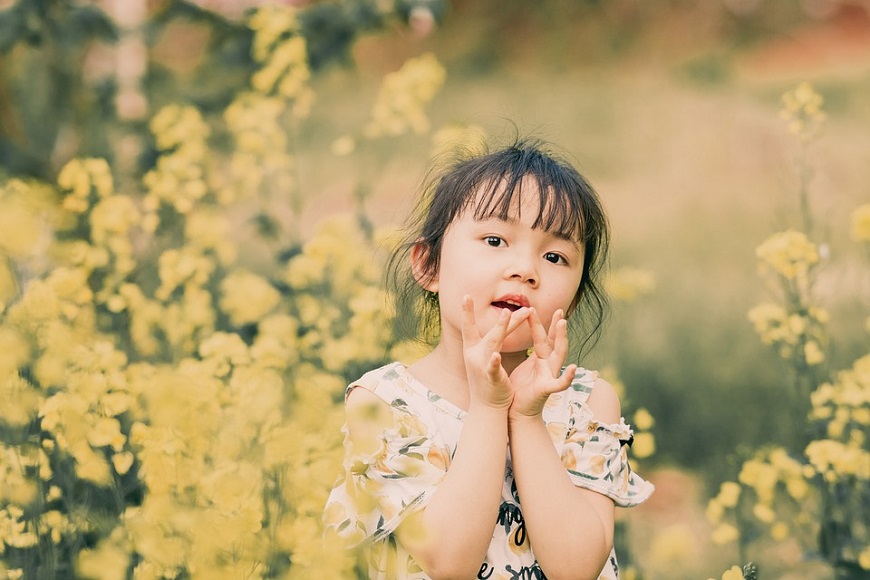
The art of greeting in Vietnam - Source : Internet
Greetings in Vietnam: a delicate art
The universal "Xin chào!"
The basis of every greeting: “Xin chào” (sin tchao) is the equivalent of “hello” and is used in all situations. It is accompanied by a smile and a slight inclination of the head.
Nuances according to age and social status
After “Xin chào”, the Vietnamese often add honorific terms to mark respect:
• Age:
For older people: “Ông” (ong) for a man and “Bà” (ba) for a woman (equivalent to “sir” and “madam” but with a more respectful connotation).
For people your own age or slightly younger: “Anh” (anh) for a man and “Chị” (chi) for a woman (equivalent to “brother” and “sister”).
For younger people: “Em” (em) for a man or a woman (equivalent to “little brother” or “little sister”).
• Social status:
For people of higher status: The same honorific terms are used as for older people.
Between colleagues: The terms “anh” and “chị” are often used, even if the people are the same age.
Examples of greetings
To an older colleague: “Xin chào anh/chị. Hôm nay anh/chị khỏe không ạ?” (Good morning, sir/madam. How are you today?)
To a friend: “Xin chào em/anh/chị. Mình đi đâu thế?” (Hello, little/big brother/little sister. Where are you going?)
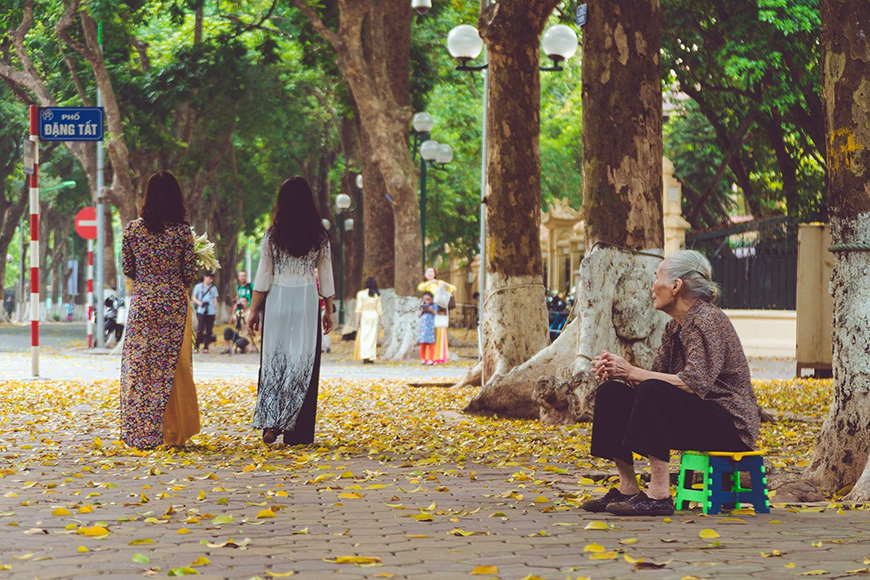
Dress code in Vietnam, women wearing Ao Dai - Source : Internet
Etiquette, a bridge to exchange
In conclusion, mastering the subtleties of Vietnamese etiquette is not only a sign of respect for the local culture, but also a great way to create authentic connections with the locals. By showing openness and embracing these cultural differences, the traveler opens up to a rich and unforgettable experience. Beyond rules and conventions, it is in sincere and respectful exchanges that the true beauty of travel lies.
Vietnam, with its thousand-year-old culture and welcoming people, offers a unique opportunity to immerse oneself in a society where tradition and modernity dance in harmony, inviting every visitor to become, for the duration of a stay, an ambassador of savoir-vivre and mutual understanding.